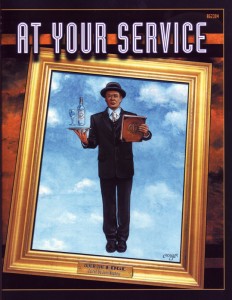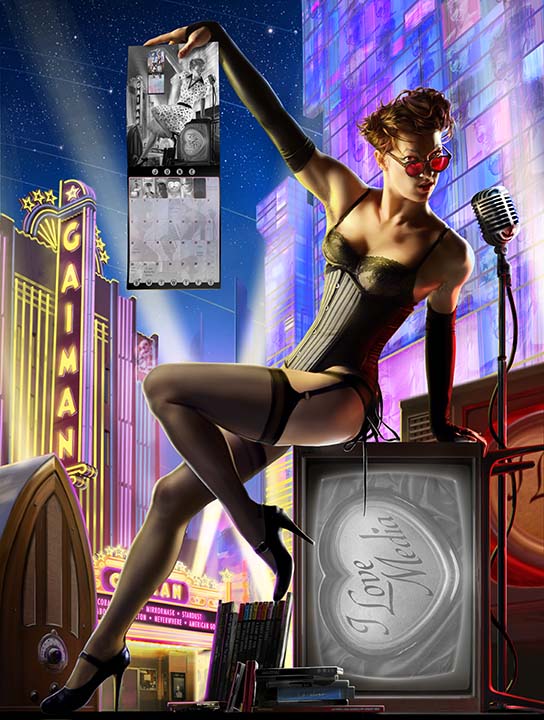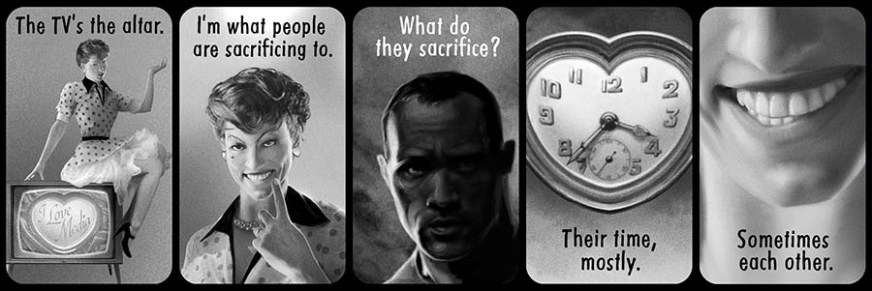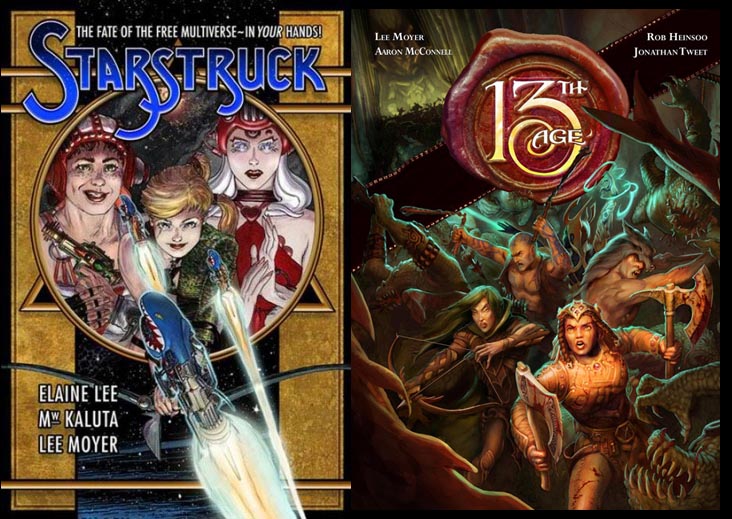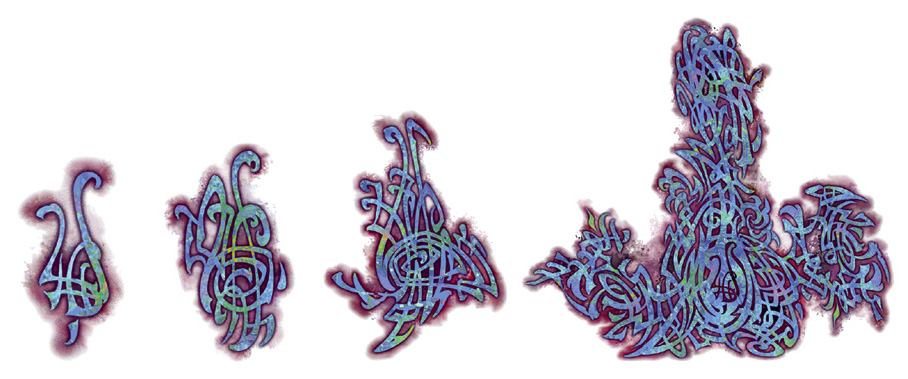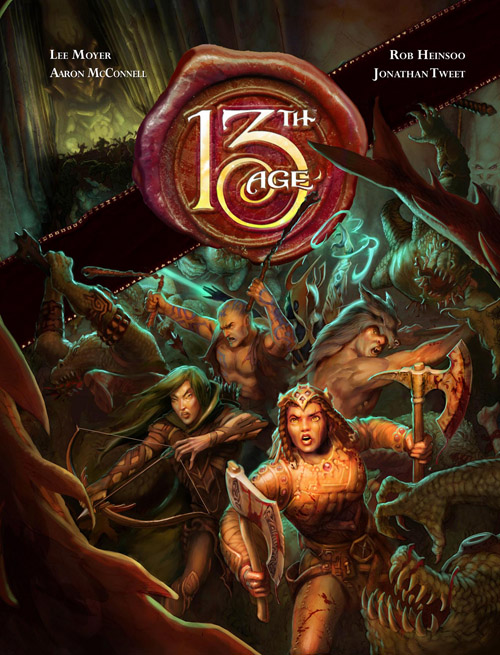 A few years back I had a chance to work with Rob Heinsoo, Jonathan Tweet, and Lee Moyer on the roleplaying game that eventually became 13th Age. While I was only involved in the early concept phase, it was a great opportunity with an amazing team. After many delays, 13th Age is finally in print. Since some people may be interested in running a 13th Age campaign in Eberron, it seems like a good time to repost something I wrote back in 2012.
A few years back I had a chance to work with Rob Heinsoo, Jonathan Tweet, and Lee Moyer on the roleplaying game that eventually became 13th Age. While I was only involved in the early concept phase, it was a great opportunity with an amazing team. After many delays, 13th Age is finally in print. Since some people may be interested in running a 13th Age campaign in Eberron, it seems like a good time to repost something I wrote back in 2012.
If you were to run an Eberron game using 13th Age, what would you use for Icons?
Some of you may be saying “What’s 13th Age, and why does it need Icons?” So let’s clear that up. 13th Age is a new roleplaying system developed by Rob Heinsoo and Jonathan Tweet, with a little bit of help from yours truly in the very beginning. The Icons are central part of the default setting of the game and of the system itself. The Icons are thirteen powerful NPCs who exert a tremendous amount of influence on the world, and who in many ways embody central themes. The High Druid is a force of nature, while the Archmage and the Emperor are forces of civilization and order. The Priestess speaks for all the deities of light, while the Diabolist traffics with all manner of dark forces.
OK: there’s some powerful people in the world. What makes this central to the game? Why would you need to have Icons if you wanted to use the 13th Age system to play Eberron? During character creation, you get three points to spend on connections to Icons, and these connections define your character’s background and affect ongoing gameplay. Consider the following example:
Lyssa Calton sets her connections as Emperor 2 (positive), Lich King 1 (negative). Discussing things with the GM, she works out the idea that she comes from a powerful noble family in the Dragon Empire, and that her ancestors were instrumental in one of the Lich King’s worst defeats. As a result, he has laid a curse on her family: whenever someone of her bloodline dies, they become undead servants of the Lich King. Right from the start, this gives the GM lots of hooks to work with. Lyssa obviously will want to find a way to break the curse. Family honor calls on her to oppose the Lich King. And in the meantime, due to the position of her family, she might be called on to serve the Empire in some way, or used as a pawn in a scheme to dethrone the Emperor. However, these relationships can also have in-game effects on the fly. For example, when the adventurers are stopped by an Imperial patrol, Lyssa could see if her connection with the Emperor allowed her to influence the guards and command their assistance. And while the relationship with the Lich King is a negative one, she can still be creative with it; perhaps the curse can allow her to infiltrate a band of undead, as they already perceive her as one of them.
So: a relationship with an Icon helps define a character and drive a story, but it is also a concrete in-game tool in the character’s arsenal. If you’re using the system in Eberron, you’re going to what something to take its place. What will it be?
It’s not a simple question. In many ways, Eberron was intentionally designed NOT to have figures like the Icons. There’s no clear equivalent to the Archmage or the Emperor; all the human rulers are about equal in power (well, except Queen Diani of Thrane). Keeper Jaela is the most powerful priestess, and yet in many ways Krozen matches her in influence… and where the Priestess of 13th Age speaks for all the gods of light, Jaela is tied only to the Silver Flame. There is no one Elf Queen or Dwarf King.
Given this, I think the best choice is to try to address the underlying role of the Icons—defining the background of your character and giving you influence within the game. With that in mind, I think the list has to be based on your campaign. Who do you see as the major players? Consider the following.
Hands of the Twelve: From start to finish, this campaign is going to revolve around the Dragonmarked houses: their internal rivalries, the balance of power between the houses and broken Galifar’s nobility, the growing power of House Tarkanan and the aberrant dragonmarks. Each house has its personal agendas; as the PCs rise in power, they will need to decide whether to embrace that goal and bring it to pass, or whether to change the direction of their house. The Icons are each of the individual dragonmarked houses, the Twelve as an institution, and House Tarkanan. Each character is a member of one of the houses they are tied to and bears the dragonmark of that house; when they use the mark in a creative way, use Icon relationship dice to determine how effective it is. When a player takes a point of relationship with a house, she should also pick an individual who’s her personal patron/ally/enemy/rival in that house; this puts a human face on things in addition to reflecting a connection to the house as a whole.
Return of the Host: The Sovereigns and Six Don’t manifest in the world directly. But following the Mourning, they can no longer sit idly by – so they have chosen mortals to serve as their hands in the world. Here the Icons are the gods of the Sovereign Host and the Dark Six; you could choose to add in other divine or immortal forces, such as the Silver Flame or Undying Court. Relationships reflect alliances or feuds, and these don’t have to all be on the obvious sides; while a Player Character may serve Aureon, it’s possible that he has angered Dol Arrah and the Shadow. Alternately, an artificer could be chosen by both Onatar and the Traveler; over the course of his adventures, he will have to decide which path to follow, and bear the consequences of that choice.
Lords of Sharn: The DM has declared that the entire campaign is going to be set in Sharn. As a result, the Icons for the campaign are on a much smaller scale that you’d normally expect. Instead of the Prince of All Thieves, you can have the Boromar Clan and Dassk as Icons. Even here, the GM should decide who the major players are going to be: by the book, Daask, House Tarkanan, the Boromar Clan, and the Tyrants are all influential criminal forces; however, she may decide that the Boromar Clan is the only one that is going to get full recognition as an Icon, and that a relationship with the Boromar Clan reflects overall ties to the criminal underworld. Similarly, I’d pick one or two dragonmarked houses (probably Cannith and Tharashk, personally) as worthy of being Icons in the campaign; you don’t want to dilute the list by offering too many choices, and you can use this relationship to determine influence with allied houses. So following this, my personal Sharn list might be:
- The City Council
- The City Watch
- The King’s Citadel
- Morgrave University
- The Boromar Clan
- House Cannith
- House Tharashk
- House Tarkanan
- The Church of the Silver Flame
- The Sovereign Host
- The Blood of Vol/Order of the Emerald Claw
- The Aurum
- A Nation (Choose one)
I’ve thrown on “A Nation” as a way of suggesting a character with a strong connection to a nation’s government – from a gnome who’s got friends in the Zil embassy to a Brelish nobleman. Tarkanan and Tharashk could be pulled if you didn’t plan on having a lot of dragonmarked hijinx, but I think that they each bring good story potential to the table.
As with the Dragonmarked example, I’d have each character choose a specific ally/patron/rival/ally to be the face of each Icon they choose. They have ties to the Silver Flame – are they agents of the corrupt hierophant or of a more lowly but dedicated priest?
There may seem to be some significant gaps here. What about the Chamber? The Lords of Dust? The Dreaming Dark? The list of possible Icons goes on and on. In part, I dropped these because the longer the list, the less impact each Icon has. Another reason to drop these groups is because they are secretive. Part of the point of the Icons is that everyone knows who they are and that their names alone carry influence; with the Lords of Dust, a player character tied to their schemes probably won’t even know it for a long time, let alone have an opportunity to do name dropping.
In general I encourage you to decide which groups will be the most influential in your campaign. Yes, the Lords of Dust and the Chamber are both powerful forces capable of exerting global influence. But do you want them to do so in this campaign? An Icon chosen by a player character will potentially play a role in every session – are you prepared to use the potential Icon in that way? Just as a player’s choice of Icons defines their personal story, your choice of Icons defines the story of the campaign. If the Daelkyr are available as an Icon choice, people should expect them to have an impact; if you’re not interested in that, don’t put them on your list.
I’m not sure I 100% agree with choosing a specific patron, personally… while an Icon may be killed, the advice given was that that should probably be a very major event, maybe even a campaign conclusion. This would still apply to a house or organization falling. It doesn’t really apply if your patron is a lowly priest.
Perhaps I wasn’t clear. When I suggest choosing a patron, it’s not to have that patron serve as the Icon. A lowly priest doesn’t serve the same role as the Priestess. However, the same can be said of Ythana Morr – and the fact that she is technically the leader of the Silver Flame in Sharn doesn’t mean she’s the one who’s going to be the best story match for your character. The ICON in this case is the Church of the Silver Flame. That is the force you are connected to; you should establish the basis of that connection; and it’s your connection to that entire organization that should be taken into account when you use your relationship dice, not the patron. The patron is simply a bonus, in part to make up for the fact that these organizations DON’T have a single face; again, Ythana’s no more the true face of the Silver Flame in Sharn than Flamebearer Mazin Tana, and as you say, the death of either one of them won’t be the end of the Silver Flame in Sharn; if you lose your rival, I’d just sit down with you and pick a new ally/rival/patron tied to the force. For example, say you’ve got Mazin as an ally, and because of the work you do together he dies; you might now gain an enemy in Ythana Morr because your work has been exposed, or perhaps Mazin’s daughter will blame you for his death.
So again: the ENTITY is taking the role of the Icon, and you need to define your history and relationship with that entity. The idea of adding an individual – whether a patron, rival, friend, or enemy – is simply a further way to develop the history of your character. In particular, if you look to the Hands of the Twelve idea, the point is that three characters could all be from House Cannith and make that their most important relationship – but they may all have secondary relationships with different individuals in the house.
I noticed you didn’t address one (I think common) campaign type, though: The international intrigue game.
Correct, because it’s not a question with an easy answer; it’s what I was covering with the last paragraph of the first answer. I feel it is important to limit your list of icons to around 10-15, both for the sake of the players and the story. If I simply listed every possible force that COULD be considered an icon, it would be way over that; in the Thronehold nations alone you hit that number, and that’s not including churches, dragonmarked houses, groups like the Emerald Claw or Aurum, or potentially the more secretive manipulators. As such, I really feel that you need to decide which of these forces are the REAL movers and shakers in this campaign. A global game may involve every nation in some form. But are Q’barra and the Lhazaar Principalities actually as significant or influential in the story you envision as Thrane or Aundair? Will the faith of the Sovereign Host actually play an Iconic role? For that matter, will the Church of the Silver Flame play a role that isn’t covered by, say, Thrane or Aundair? Do you want the Twelve as a single Icon, or do you want to pick one or two houses that are going to be particularly important to the action of the campaign?
So let’s look at ONE EXAMPLE of a political intrigue game. I’m going to use this list of Icons.
- Aundair
- Breland
- Cyre
- Karrnath
- Thrane
- Darguun
- Droaam
- The Eldeen Reaches
- Valenar
- House Cannith
- House Thuranni
- The Aurum
- Blood of Vol/Emerald Claw
- Church of the Silver Flame
- The Lord of Blades
This campaign is going to focus on the cold war between the Five Nations and the threat of a new war, which will be assured if the mystery of the Mourning is solved. Droaam, Darguun, and Valenar will all have active roles, and the potential of open conflict with any of the three is possible; the relationship between Aundair and the Eldeen Reaches will also be an issue. The Church of the Silver Flame will have a role to play outside of Thrane; for example, a Brelish character could be a respected templar with a significant relationship with the Church yet who opposes the theocracy in Thrane. While all of the dragonmarked houses will be involved, only two will have major roles. Cannith may be critical in solving the Mourning, and with war on the horizon, every nation is trying to forge stronger ties with the House of Making. Meanwhile, Thuranni is going to be acting as a significant opposing force to the national intelligence agencies… but who are they working for? As noted before, the Chamber and Lords of Dust are both involved in this campaign, but both are deep enough behind the scenes that I’m not including them as Icons.
Players don’t actually have to have a relationship with a nation to be from that nation. A relationship implies a close tie to the powers and interests of that nations. A tie to Breland may make the player a noble, a ranking agent of the Citadel, a prominent member of the anti-monarchy movement… or of course, it could mean that he’s made powerful enemies in that nation or has some other form of negative relationship there.
But I could easily come up with an entirely different campaign model. One point I’ll make is that 13th Age only runs through character levels 1-10; In planning a campaign story, you’re not looking for a 30-level arc.
What do you think should happen with Icons that are secretive, like say the Scar that Abides?
Personally, I don’t consider them to be “Icons.” I was involved in the early concepting stages of 13th Age, when the list of Icons was being developed. One of the possibilities we considered was an evil force in the underworld that was the source of aberrations, not unlike the Daelkyr. Ultimately we decided that while such a thing might exist, it didn’t fit the role of “Icon.” While it might have a significant role within the world as a threat, people couldn’t interact with it directly; only a few of the other Icons interacted with it, and even then not directly (little possible beyond “hold it at bay”) and there was little possibility of friendly interaction. Could you have a story/background tie with it? Sure. You’re a half-blood aberration. Your family was killed fighting the aberrations. But overall, its impact on the world is one-sided and limited. By contrast, the Lich King’s impact on the world is obvious; he has history with the other Icons; and it is actually possible for other forces to negotiate with him or interact with him or his lieutenants. Someone could form a temporary alliance with him; the Dragon Empire could decide to go to war against him; the Archmage could reveal that the Lich King is his father; the Prince of Shadows might have the Lich King’s heart in a chest.
So in other words, secret forces can be part of backgrounds and they can be tied to unique things whether they are Icons or not. They could be just as powerful or even more powerful than the Icons. But for me, the purpose of an “Icon” is that it shapes the world both in its own right and through its constant interactions with other Icons. Looking to the Diplomacy game, having Aundair, Thrane, and the Church of the Silver Flame as separate Icons shows that you’re dealing with the way all three of these affect one another as separate forces. It may be that the Chamber and the Lords of Dust are pulling the strings of all three of them – but if none of them KNOW it, then the story as the world perceives it remains about the interaction between church and nations, and those are what I’d choose as my Icons.
But your mileage may vary! It’s just a question of what it means to be an Icon.


